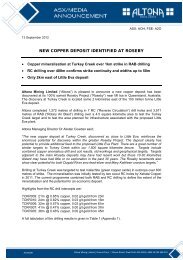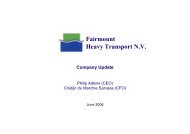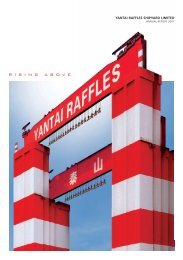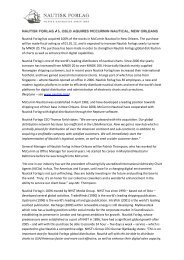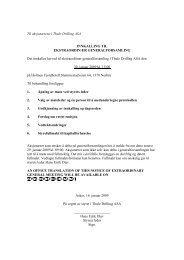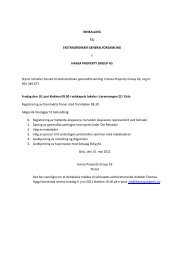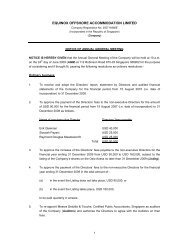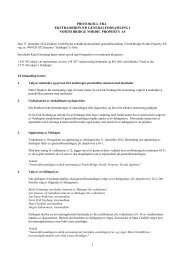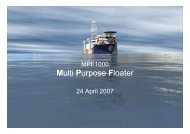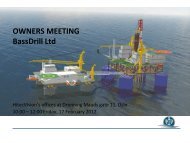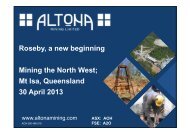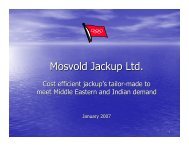Create successful ePaper yourself
Turn your PDF publications into a flip-book with our unique Google optimized e-Paper software.
Marine Subsea Fleet<br />
Offshore Intervention Vessels<br />
Key features<br />
Class:<br />
Length:<br />
Width:<br />
Draft:<br />
Deck Area: 1 470 m 2<br />
Accommodation:<br />
Deadweight:<br />
Speed:<br />
Crane capacity:<br />
Module handling<br />
tower;<br />
140 t<br />
Dynamic<br />
Positioning: 3<br />
Intervention depth: 2 500 m<br />
+ DNV 1A1 R Ship-shaped Well Intervention<br />
Unit SF LFL* COMF-V(3)C(3) HELDK<br />
CRANE OPP-F E0 DYNPOS-AUTRO NAUT-<br />
OSV(A) CLEAN DESIGN DK(+) HL(2.8)<br />
MODU CODE Safety Certificate<br />
120,2 m<br />
25 m<br />
7–5 m<br />
100 persons<br />
40 single & 30 double cabins<br />
Roll reduction tanks<br />
Diesel-electric propulsion<br />
8 700 t<br />
14,5 knots<br />
2 Work Class ROV’s, 3 000 m<br />
140 t<br />
The two SX121 vessels Sarah and Karianne are designed as state of the<br />
art Offshore Intervention vessels. Both have multiple usage functions and<br />
are particularly well suited for subsea construction and well interventions.<br />
Subsea well intervention, which is regarded as a very promising market,<br />
entails improving oil recovery from wells that have been in production for<br />
some time. The operation is typically performed by lowering specialized<br />
tools through the moon pool of the vessel, into the well. These tools can<br />
then perform production logging, re-perforation, lubrication etc., with the<br />
objective of improving oil recovery. Traditionally, these operations have<br />
been carried out by exploration semi-submersibles. However, with rig rates<br />
being significantly higher than for vessels, subsea well intervention operations<br />
can be performed faster and more economically from purpose built<br />
vessels such as Sarah.<br />
Both Sarah and Karianne, are practically identical. The vessels have the<br />
characteristic new X-Bow shape, which enables better fuel efficiency,<br />
more space for accommodation in the bow of the vessel and better motion<br />
characteristics.<br />
The vessels are dynamically positioned (DP3) and hence do not require<br />
mooring lines when stationed over the object. The vessels are designed<br />
with a central moon pool in the deck and with a 140 t heave compensated<br />
tower above. They have also a 140 t heave compensated crane and both<br />
the tower and crane are rated for 2 500 m water depth<br />
The hulls of vessels are being built in the Ukraine, while completion and<br />
commissioning is performed at Ulstein Group’s shipyard in West Norway.<br />
<strong>Annual</strong> <strong>Report</strong> 2009 Marine Subsea 13




